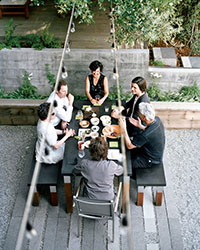A Bay Area landscape designer works her yard like a jigsaw puzzle, packing a bevy of distinctive destinations into a steep and diminutive plot.
 Until a few years ago, Loretta Gargan had spent her entire career as a landscape designer creating outdoor havens for other people, without a proper yard to call her own. But don’t feel sorry for her: She never felt deprived. “I’ve always interpreted a feeling of nature wherever I am, no matter the context,” she says. “Even putting big branches in a vase or arranging rocks—that’s enough to make me happy. It’s not about the space; it’s about envisioning what you can do with what you have.”
Until a few years ago, Loretta Gargan had spent her entire career as a landscape designer creating outdoor havens for other people, without a proper yard to call her own. But don’t feel sorry for her: She never felt deprived. “I’ve always interpreted a feeling of nature wherever I am, no matter the context,” she says. “Even putting big branches in a vase or arranging rocks—that’s enough to make me happy. It’s not about the space; it’s about envisioning what you can do with what you have.”
That vision served her well six years ago, when she and her partner, the artist Catherine Wagner, first visited the one-bedroom shack in Marin County, California, that would become their weekend retreat. The house and land were sorely neglected. “Things were growing haphazardly because they’d been planted by squirrels and birds,” recalls Gargan. “Oaks and cotoneasters were popping up all over the place. The whole property was on this gentle slope, which meant you couldn’t put a chair down without tipping over.”
The couple hired San Francisco architect Jonathan Feldman to renovate and extend the cottage while maintaining its historic charms, which include old-growth Douglas fir ceiling beams and a 1930s stone fireplace. Feldman designed a two-story addition that contains a master bedroom and bath upstairs and, downstairs, a living room with sliding glass doors that open wide to the landscape. Feldman describes it as an “open-air pavilion below, tree house above.”
Gargan and Wagner spent weekends at the property for three years before tackling a full-scale landscape redesign; during that time, they wrote and revised their list of desires. This included a dining deck where they could host parties; a lap pool and spa; a green roof atop the detached garage; and various patios where they could lounge throughout the day, chasing or escaping the sun depending on their mood and the season.
To create the landscape plan, the couple first “mapped the idiosyncratic plants that had to stay,” says Wagner, including old oaks and a hundred-year-old olive tree intertwined with a vigorous climbing white rose. They set the 36-foot lap pool in the sunniest spot. Gargan then fit all the other components around the site, grading the slopes and creating patios, and “working on the space as if it was a puzzle to fit in as much as possible in a relatively small area.” She planted native grasses, edible plants, and African blue basil, the last selected for its potent bee-attracting properties (“it’s kind of magical—you always have company,” she says). The green roof blooms with poppies, strawberries, and a spectrum of native wildflowers.
Their plan was ambitious, considering the lot—one of the smallest in the town of Ross. Even Feldman was mildly alarmed: “I was expecting, maybe, half the lines on the paper,” he says of his first glimpse at Gargan’s drawings. But thanks to Gargan’s experience designing tight urban gardens, maximizing every square inch came naturally. Today, the couple has just one complaint: With so many distinctive places to be, weekend visits always feel short. “There’s not a bad location,” says Gargan. “You can move around the property all day and never have enough time to sit everywhere!”
